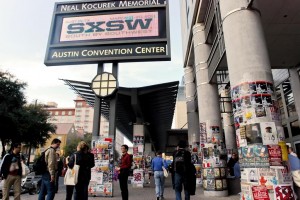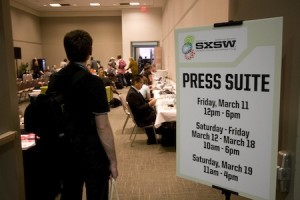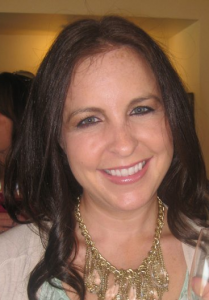 |
| Outside Austin Convention Center (credit: Brittany Ryan) |
It must be that silly SXSW season again. I caught my pal Brian Solis’s tweet of the name of the opening keynoter for the 2012 SXSW Interactive festival in Austin. He’s Baratunde Thurston of The Onion, which this week celebrated the 3 million mark in Twitter followers. (Who’d a thunk?)
I also noticed that the SXSW PanelPicker, which gives the online community a voice in anointing the chosen speakers/topics, went live. Of course it’s impossible to consume everything SXSW has to offer. I did still manage to churn out a decent bit of blog fodder from last year’s keynotes, parties and panels.
 |
| SXSW Press Room (credit: JW Walthall) |
It entailed toiling for more than a few hours in the press room with the other credentialed journalists who seemed to represent every shade of the journalistic spectrum. It got me thinking: just how many journalists covered this mammoth festival and how was credentialing decided given the stark changes we’ve seen in the media order?
Could SXSW have drawn more than the 600 journalists this PR person accredited for the 2004 dedication of the National World War II Memorial in DC?
I do know this: the attendee demo couldn’t have been more different between the two events. We hosted some 140,000 octogenarians on the National Mall that Memorial Day weekend. SXSW clearly caters to the 20 and 30-something crowd (and the marketers who covet them).
I decided to pose a few questions to Kelly Krause who handles Interactive Press & Publicity for SXSW, Inc. She also directed me to the fact sheet on last year’s event from which you’ll learn that more than 19,000 people from 63 countries attended the Interactive festival alone. Here’s more of what she had to say:
 |
| SXSW, Inc’s Kelly Krause |
PH) How many journalists did SxSW Interactive accredit to cover this year?
KK) We had approximately 2,508 in attendance for the Interactive event, including Gold & Platinum badges.
PH) What was the journalist breakdown between mediums, i.e., mainstream versus bloggers…and newspapers, magazines, TV, radio, web only.
KK) As you can guess with an Interactive event, the bulk of our press had an online/blogging presence. In order of most attended, it was: online/bloggers, newspapers, magazines, radio and TV.
PH) How did the media accreditation process work and how specifically was it determined which journalists qualified?
KK) We began accepting press applications after Labor Day on September 6, 2011 and that process is open through February 8, 2012. Folks apply via an online application, which asks detailed questions about the outlet, coverage plans and number of folks from the outlet/crew, etc. We spend a lot of time reviewing these applications, so the more detailed the better. We also take into consideration how relevant the outlet and content is to our festival and if you covered last year, did you send us your coverage? A lot of times we’ll have press applying for a Platinum badge (Music + Film + Interactive) but if they only cover one of the events, we’re less-likely to grant them that same badge the following year. We take pride in our application process and want to credential folks who are eager to attend and cover. On that note, I’d encourage press to apply earlier than later this year to avoid problems with booking a downtown hotel, as those are the first to go!
PH) What did you offer accredited journalists via the press room, i.e., broadband, refreshments?
KK) GoToMeeting sponsored the press suite and provided nice notebooks & pens (which I use everyday) — we also had refreshments, computers with Internet access and WiFi.
PH) Other than a place for journalists to work from, what else was the press room utilized for?
KK) Most journalists found this to be a great spot to hold quick interviews, file pieces and connect with fellow journalists. We also held a launch event for 10 exhibiting companies that were launching or had breaking news during SXSW. They each gave a 3-minute elevator pitch about their new launch to press and we provided a brunch buffet and mimosas.
PH) I noticed that Samsung sponsored the official “Blogger Lounge.” How did the lounge play into your PR plan?
KK) The Blogger Lounge was much different than the press suite as there were Tweetups, contests and featured appearances all hosted by Samsung. So, we didn’t push this as the quiet place to file quick stories or do interviews, rather a place to mix-and-mingle with your community and learn about Samsung’s new products and services.
PH) What was the process through which journalists could gain access to the more notable speakers on the program?
KK) Most press just emailed me to get in touch with our keynote speakers and I funneled them through to their rep. However, our app, SXSocial, made it easy for them to reach out directly. I’m always happy to direct press to an appropriate contact, but it’s up to their rep whether they will partake in interviews.
PH) I noticed that you had a meet & greet for credentialed press with conference organizers on the first day. How did that go and what was the turnout?
KK) We had a Welcome Press Brunch on Saturday, sponsored by FileMaker that was well-attended, as well as the Press Launch in the press suite that was quite popular as well
PH) What was this year’s SxSW Interactive’s overriding communications goal?
KK) The media loves to cover our growth — and we’re happy the event is growing — but there’s so much more to SXSW Interactive than our attendance numbers. So, it was important for us to really showcase and highlight our roster of notable speakers, new events and sponsors that really enhance the “SXSW experience,” and even more, how and why they are relevant to the community.
PH) What was the most unusual media request you received this year?
KK)Thankfully the press were pretty easy on me for my first year on the job. However, after working in “Hollywood,” no request seems too unusual anymore. PH) How big was the communications staff for SxSWi? KK) I’m the sole Publicist for SXSW Interactive, though I utilize Porter Novelli’s Austin office throughout the year and during the event to help with strategy, pitching and on-site staffing for the various Interactive events.
PH) Did you capture and measure the resulting media coverage for SxSWi? If so, how did the coverage this year compare to last year?
KK) We use Cision to monitor and track our coverage, and as the event grows, so does the amount of coverage.
PH) Looking back, what would you do differently next year?
KK) Aside from getting more sleep, wearing comfier shoes and having a massage lined up post-event? Good question. It’s hard to assess what you would change because each event is so different from the next. I gleaned a lot of good insights from our Registrant post-event surveys (yes, we do read those), so will definitely take some of that stuff into consideration for next year. My most important goal is to make sure I’m getting the right messages & information out to the press and our registrants and that I’m able to answer any questions along the way. I finally had to come to terms with the fact that I can’t be at every Interactive panel or event, but I can do a good job at making sure press get what they need before, during and after (within reason).
PH) The many sponsors this year all had in-house and outside PR representation. How did coordination between the conference organizers and its sponsors work? And which sponsoring company or startup, in your opinion, did the best job in rising above the noise?
KK) Our Sales and Sponsorship team work very hard to ensure sponsors needs are met and there’s a synergy between both entities. And to that extent, we (Publicity team) are constantly looped in on sponsor activations and launches. It’s hard to say who specifically rose above the noise this year. We had a lot of great feedback from Chevy’s “Catch a Ride” program and a lot of folks who couldn’t attend SXSW were thankful for PepsiCo sponsoring the livestream of our keynote sessions — there are so many amazing sponsors, it’s difficult to choose. To that extent, every year press try and determine which company had the most successful launch. While Group Messaging and Gamification were definitely trending during the event, in my opinion, no particular company won — it was the hundreds of entrepreneurs as a whole who rose above the noise.
PH) What were you most proud of at this year’s event?
KK) Right after the devastating earthquake and tsunami in Japan, the SXSW community immediately banded together and rallied to raise support for Japan, virtually overnight. When I arrived to the Austin Convention Center early in the morning following the bad news, a few attendees had already set up a booth, SXSW4Japan was created and everyone was asking how they could get involved — from press changing the focus of their session to discuss Japan, to musicians streaming a live telethon to raise money — the community took great advantage of technology and their resources at hand to put their influence to work. It was a true sign of how caring, connected and savvy our community is, and I was proud to be a part of it. Note, you can still get involved with SXSW4Japan / SXSWCares here: http://www.sxsw4japan.org/